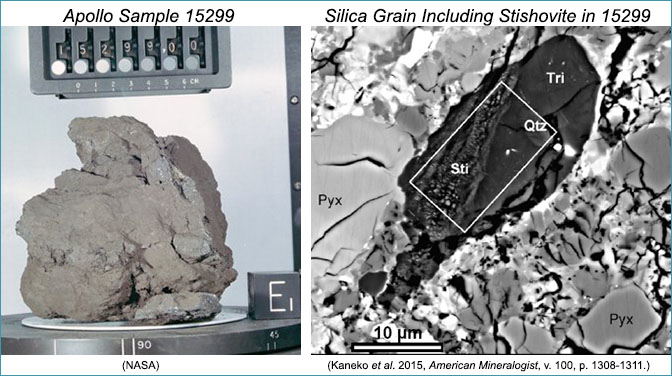Quick Views of Big Advances
First Discovery of a High-pressure Polymorph of Silica in an Apollo Sample
The Moon's history of impact bombardment is writ large in its basins, impact craters, regolith, and breccias. But sometimes it's the smallest geologic details that tell us more about the effects of the bombardment history. In this case, it's the first discovery of a high-pressure polymorph of silica in a returned Apollo rock that shows effects of high-pressure shock.Evidence of the high pressures and high temperatures associated with impact events can be seen in crystals modified by shock. Such evidence has been found previously in lunar meteorites, such as high-pressure forms of silica in Asuka 881757 [Data Link from the Meteoritical Bulletin] by Eiji Ohtani (Tohoku University, Japan) and colleagues. But until recently, high-pressure polymorphs of silica had never been seen in any of the samples returned by the Apollo astronauts. This changed when the team of Shohei Kaneko (Tohoku University, Japan) and colleagues investigated the lunar regolith breccia–sample 15299–with an impressive array of laboratory techniques, such as focused ion beam (FIB), synchrotron X-ray diffraction (XRD), and transmission electron microscopy (TEM), to identify stishovite in one of the silica grains. Based on previously determined pressure-temperature phase diagrams, the presence of stishovite means the rock was subjected to at least 8 GPa of shock pressure. Because this regolith breccia resembles the regolith near the Apollo 15 landing site, it may have come from an impact crater in the local area. Or, as Kaneko and coauthors suggest, it may have formed during the impact that created the Imbrium basin.
A side note: Apollo sample 15299 is one of the rocks included in NASA's Lunar Petrographic Educational Thin Section Set.
![]() (pdf version)
(pdf version)
See Reference:
· Kaneko, S., Miyahara, M., Ohtani, E., Arai, T., Hirao, N., and Sato, K. (2015) Discovery of Stishovite in Apollo 15299 Sample, American Mineralogist, v. 100, p. 1308-1311, doi: 10.2138/am-2015-5290. [ abstract ]
See also:
· Ohtani, E., Ozawa, S., Miyahara, M., Ito, Y., Mikouchi, T., Kimura, M., Arai, T., Sato, K., and Hiraga, K. (2011) Coesite and Stishovite in a Shocked Lunar Meteorite, Asuka-881757, and Impact Events in Lunar Surface, Proceedings of the National Academy of Sciences, v. 108, p. 463-466, doi: 10.1073/pnas.1009338108. [ abstract ]
· Samples for Education: NASA's Lunar Petrographic Educational Thin Section Set, intended for use in college and university courses in petrology and microscopic petrography for advanced geology students.
Written by Linda M. V. Martel, Hawai‘i Institute of Geophysics and Planetology, for PSRD.
|
|
[ About PSRD | Archive | CosmoSparks | Search | Subscribe ] [ Glossary | General Resources | Comments | Top of page ] |

